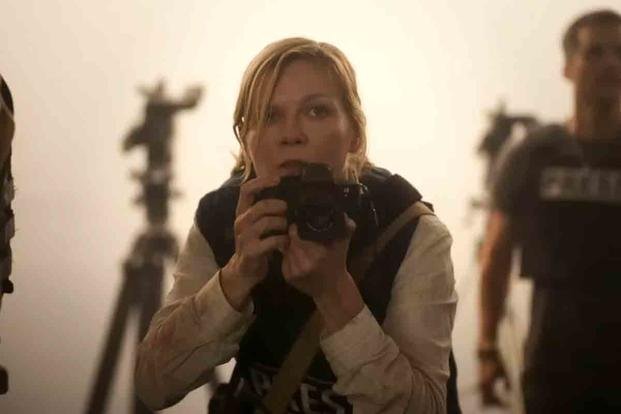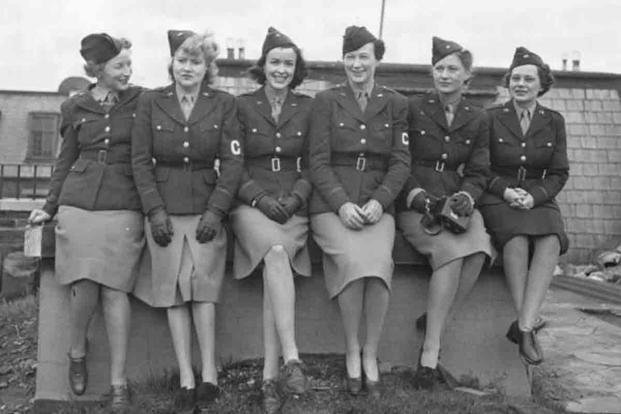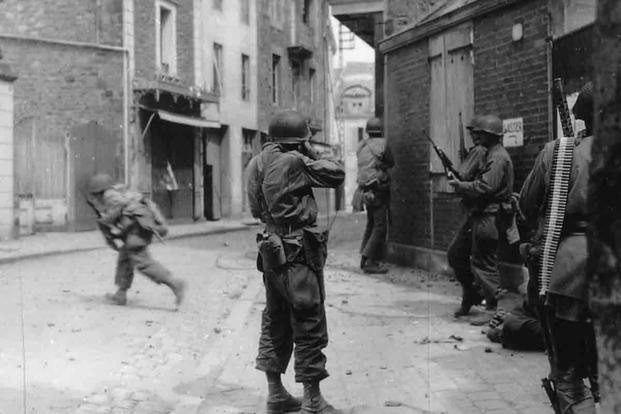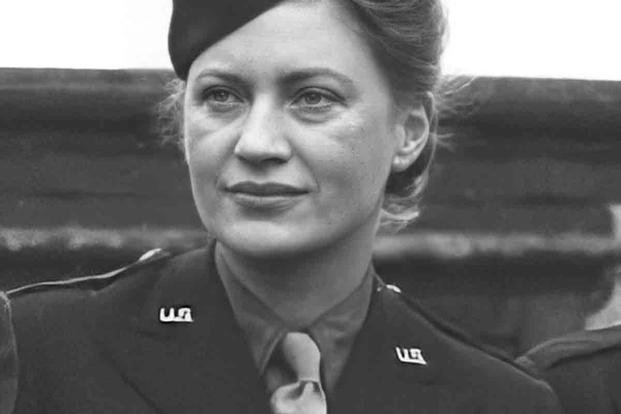Lee Miller kept Adolf Hitler’s address in her pocket for years. When the legendary photojournalist finally arrived at the Nazi dictator’s secret Munich apartment on April 30, 1945, while embedded with the U.S. Army’s 179th Infantry Regiment, the first thing she did was wash the dirt from the newly liberated Dachau concentration camp off herself -- using the Führer’s bathtub. Life Magazine correspondent David E. Scherman snapped a now-famous photo.
The same day, Hitler killed himself in a bunker in Berlin. Miller, the only woman photojournalist to advance with the Allied forces across Europe, would wake up in his bed the next morning. In little more than a week, World War II in Europe would be over. It was a long walk from her hometown of Poughkeepsie, New York, to the front lines of the Second World War, but along the way, Miller would become one of the most celebrated photographers of the conflict.
Miller wasn’t the first female combat correspondent, but her legacy is currently having a moment. She was the subject of the 2020 documentary “Capturing Lee Miller”; in 2023, her story would get its own feature film in “Lee,” starring Kate Winslet as Miller and Andy Samberg as Scherman. Now, Kirsten Dunst portrays a weary combat photojournalist aptly named “Lee” in the 2024 movie “Civil War,” a tribute to the trailblazing photographer in every way -- including her success and abrasiveness.
“Being photographed by Lee Miller became quite the thing to mention at a cocktail party,” her son Antony Penrose wrote in his book, “The Lives of Lee Miller.”

Born in 1907, Lee Miller was introduced to photography at a very young age, as her father was an amateur photographer who often used her as a model for his often dubious photographic experiments, which often depicted her nude while underage. Because her father was so keen on experimentation, Miller learned about the technical aspects of the craft. She would learn the artistry and composition lessons of photography in Paris at 18, at Poughkeepsie’s Vassar College at 19 and later in Manhattan.
But before she became a photographer, Miller was in front of the camera as a model -- a career launched, as the story goes, by pure luck. It’s believed Miller was discovered as a model when none other than Condé Nast himself saved her from being hit by a car on the streets of New York in 1927. Miller was on the cover of Vogue magazine within the year and was soon one of the country’s most in-demand models. But a photo taken of her was printed in an advertisement for menstrual pads, and her role as the first actual person to appear in such an ad (which was a social taboo at the time) effectively ended her modeling career.
Miller returned to Paris in 1929, where she became an artist and struck up relationships with the likes of Spanish artist Pablo Picasso. Her art career took her back to New York, where she married an Egyptian businessman, moved to Cairo, but eventually left him for London, where she lived with artist Roland Penrose, a man whom she would one day marry. While she was in London, Nazi Germany invaded Poland, World War II broke out in Europe and the city began to feel the pressure of the Blitz. Rather than come home to the United States, Miller signed on with Vogue, becoming the magazine’s official war correspondent. Soon, she had a credential for Condé Nast publications.
While there weren’t many women serving as war photographers and correspondents (there were only 100), Miller was in good company. Thérèse Bonney, a fellow New Yorker, documented the Russian-Finnish front of the war, among others, and would receive the Croix de Guerre and Legion d’Honneur for her wartime work. The legendary Martha Gellhorn, who would be the only woman to land with the Allies at Normandy on June 6, 1944, also covered the Battle of the Bulge. Mary Welsh reported on the war from London for the Chicago Daily News. Dixie Tighe was the first woman on a bomber mission over occupied Europe. Kathleen Harriman covered the war from London, first for the International News Service and later for Newsweek. Helen Kirkpatrick followed the Allies from Algeria to the Mediterranean and into the Liberation of Paris. Tania Long would enter Berlin with American forces in 1945.

Miller got an assignment in Normandy just one month after D-Day. Her coverage of an evacuation hospital on the front lines was published in a multipage piece for Vogue that went around the world. She wasn’t supposed to cover front-line combat but accidentally stumbled upon the Battle of Saint-Malo because it was reported to be liberated, but the fighting would carry on for a full month. Miller not only reported about life on the battlefield, but also the first use of napalm in combat.
Even though she just happened to be in Saint-Malo for the battle, the Army wasn’t thrilled about a woman violating the terms of her press credential and was forced to cover the Liberation of Paris. To demonstrate the resilience of newly freed Parisians, she documented their refusal to let the war diminish their artistic and fashionable flair. In a brief return to fashion photography, she shot photos of models wearing newly designed outfits on the streets of the French capital.
By November 1944, she was documenting the Alsace Campaign, which would push the German Army out of France and back into Germany itself. There, she would document the atrocity of the Buchenwald and Dachau concentration camps, as well as the burning of Hitler’s other home, the so-called “Eagle’s Nest” near Berchtesgaden.

Through her work, Miller was determined that she would photograph a historical record of the war in Europe. When combined with her “evocative” prose, her coverage of the war gave readers not just an account of what happened, but what it was like to be there and witness those things in the thick of it all. The war would take a toll on her; in later years, she suffered from depression and alcohol abuse.
Miller continued working in photography for a few years after the end of World War II, but one day, she packed up her camera and became an award-winning cook. She threw lavish parties, and even served drinks on Hitler’s own silver platter. Her photos, some 80,000, were stashed away in an attic, relics of a past life she seemed to want to forget. When Miller died of cancer in 1977, her son, Anthony Penrose, discovered them and regifted them to the world.
To see the whole body of Lee Miller’s work, visit the Lee Miller Archives website or follow the Lee Miller Archives on Instagram.
Want to Learn More About Military Life?
Whether you're thinking of joining the military, looking for post-military careers or keeping up with military life and benefits, Military.com has you covered. Subscribe to Military.com to have military news, updates and resources delivered directly to your inbox.
.
















